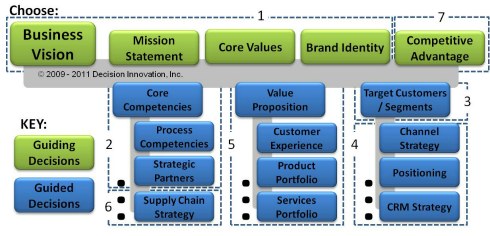Using business model innovation to create new paths to growth
Business model innovation is probably the most challenging of the innovation types as it will likely present an organization with major requirements for change. Often, the very capabilities or processes that have been optimized to make a company successful and profitable will become the targets for transformation. In some cases, these changes can threaten elements of the company identity and come into conflict with brand expectations or promises.
What is business model innovation?

A business model is a simplified representation of how the business makes money. Using our decision making model, it is the fundamental set of decisions that form the business and allow for its continued existence and profitability. For a starting business, business model generation will include choices for the following strategic decisions:
- Identity - This decision will include choices for mission, vision, core values and brand identity. It establishes how the business wants to be known to its customers.
- Core resources - This will include choices for core competencies, processes and strategic partners that allow realization of the opportunity value proposition.
- Target customers (or markets) - Decisions are made for focusing offers to specific customers or segments that will best respond to the offers from the business.
- Channel strategy - The channel for reaching the customer is identified along with choices for managing the customer relationship.
- Customer offers - Choices for products and services are identified that will create value for the customer by solving problems and meeting specific needs or desires. This will also include choices for the customer experience.
- Supply chain strategy - Choices are made for how the product and services will be created and delivered to the customers and at what cost.
A start-up's business plan essentially documents these key decisions, adding information that supports the alternatives chosen and demonstrating a viable business model. Viability is established when the revenues gathered from the customer offers exceed the costs to provide the products and/or services.
After viability the business must identify how it will be sustained in the face of competition. Choosing a competitive advantage strategy [7 on decision network] typically identifies the areas where the company will focus its innovation efforts (or investments) to maintain or increase the value provided to its customers over time.
Business model innovation looks for change opportunity in these foundational decisions. For long running businesses, these fundamental decisions may have become embedded in the culture, creating significant resistance to change.
How is business model innovation different from other types of innovation?
Unlike other types of innovation, changes to the business model require changes to the foundational decisions upon which the business operates. Therefore, business model innovation will likely be radical, and in many cases, transformational. Most innovation is incremental, such as product innovation, where technology enhancements are routinely included in product updates as a way of increasing performance or reducing costs.
 Changing the business model design brings much higher risk due to the potential for disruption to the current business. For large businesses, recognizing and managing this kind of transition can be critical to long term survival. Start-up businesses have the advantage since they can iterate and adapt their business model as they are in the process of an initial business model design. This suggests why many disruptive innovations may come from start-up businesses or small isolated teams in established businesses.
Changing the business model design brings much higher risk due to the potential for disruption to the current business. For large businesses, recognizing and managing this kind of transition can be critical to long term survival. Start-up businesses have the advantage since they can iterate and adapt their business model as they are in the process of an initial business model design. This suggests why many disruptive innovations may come from start-up businesses or small isolated teams in established businesses.
Some business model innovation examples
Many past business model innovations have come as a result of taking advantage of new technologies to make fundamental changes to one or more of the key strategic decisions under which the company operates. This has been particularly true for manufacturing based businesses where choices for core resources have evolved significantly as a result of improvements in transportation and communication technology. Examples of some large company business model transformations include:
- IBM that has managed changes in customer offers from mainframes to personal computers to technology services
- Apple that has evolved its customer offers of personal computers to music delivery devices and service that ultimately included cellular phones
- Dell's innovation of a new distribution model by allowing online customization that capitalized on improving internet technology
- Walmart's fundamental changes to a networked enterprise structure and value chain
When is it time for business model change?
Changing a business model can look very attractive because of the numerous cases cited in business books and literature. Significant successes are attributed to business model innovation, and we all want to emulate that success. An IBM Global CEO Study from 2006 provides data that shows a strong correlation between higher operating margin growth and business model innovation (versus operations or "product, service, markets" innovation).
 While business model change seems appealing, this type of innovation challenges the foundational decisions underlying the current business, disrupting the very structure that is currently paying the bills. This suggests that finding the right time for a business model change is fundamental to success. Some timing indicators include:
While business model change seems appealing, this type of innovation challenges the foundational decisions underlying the current business, disrupting the very structure that is currently paying the bills. This suggests that finding the right time for a business model change is fundamental to success. Some timing indicators include:
- Evidence of commoditization or declining industry margins
- Indications of over served customers
- Inability to keep pace with changes in your industry
- Base industry technology being used in outside industry products
- Opportunities coming from the current product/service portfolio to serve customers in outside industries
- Degradation in innovation metrics such as sales attributed to new products
Industry evolution can be unforgiving, and change can go much faster than expected, requiring diligence in the timing of a new business model design.
Don't forget the soft decisions that are part of the business model
 As identified previously, decisions on identity are often an important part of the company's business model. Core resources and competencies reflect choices for values. The company's brand represents promises delivered in its value propositions. There is a point at which proposed business model changes can remove the foundation that sustains the brand, and perhaps more importantly, the business identity. When this occurs, business model innovation may suggest restructuring of the company.
As identified previously, decisions on identity are often an important part of the company's business model. Core resources and competencies reflect choices for values. The company's brand represents promises delivered in its value propositions. There is a point at which proposed business model changes can remove the foundation that sustains the brand, and perhaps more importantly, the business identity. When this occurs, business model innovation may suggest restructuring of the company.
In the end, the business model design must be aligned to the business identity for any possibility of a successful innovation outcome.

